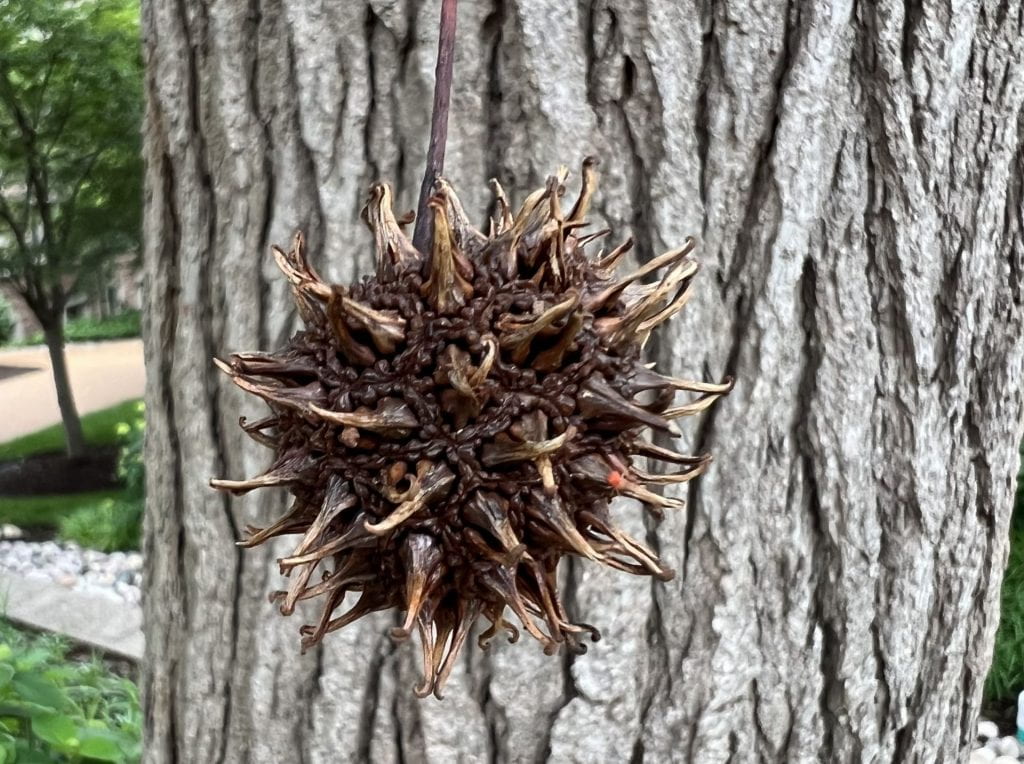Sweetgum
Arbor Walk #15, Treekeeper ID #1439

This low-maintenance deciduous shade tree is found natively in much of the Eastern US and in southeast Missouri, usually in low, wet, woodland areas or along stream beds. It is planted as a shade tree in many parks and lawns because of its ease of care and tolerance of a wide variety of soil conditions. Gum from the tree has long been used for a variety of purposes, including chewing gum, incense, perfumes, flavorings, medicines and folk remedies. The hard spiked fruiting clusters, or “gumballs” can hang on the tree all winter.
More information on the Sweetgums in our Arboretum here!


GPS Coordinates
N/A
Percent Concrete
N/A
Distance to Buildings
| Year | Close Building #1 | Close Building #2 | Close Building #3 |
|---|---|---|---|
| 2020 | Lopata Hall, 15.14 m | Cupples I Hall, 7.55 m | Sever Hall, 24.75 m |
Distance to Other Species
| Year | Close Species #1 | Close Species # 2 | Close Species # 3 |
|---|---|---|---|
| 2020 | Prunus spp., 5.62 m | Prunus spp., 5.72 m | American Hornbeam, 7.56 m |
Standard Measurements
| Year | Height (m) | DBH (cm) | Caliper (m) | Crown Diameter N-S (m) | Crown Diameter E-W (m) | Average Crown Diameter (m) |
|---|---|---|---|---|---|---|
| 2020 | 21.0586 | 65.29 | N/A | 18.34 | 13.15 | 15.745 |
| 2023 | 21.9 | 68 | N/A | 18.35 | 13.38 | 15.865 |
Nests and Pests
| Year | Description |
|---|---|
| 2020 | Some potential caterpillar cocoons, but too-high up to verify |
Leaf Identification
The leaves of the Sweetgum are simple (no leaflets), alternately arranged on the stem, and lobed. The Sweetgum has five (or occasionally seven) lobes, each with a tapered tip and shallowly serrated margin. The lobes are well divided and form a flattened star shape. The leaves are often glossy and dark green.
Twig and Bud Identification
The twig is light brown with pale ridges and lenticels (pores). The terminal bud of the Sweetgum is large, dark red-brown, ovoid, and with paired valve-like scales. Both the flowers and leaves emerge from the same bud.
Bark Identification
The Sweetgum has light gray bark with thick raised vertical ridges that form deep furrows. When young, the bark is smooth and slightly mottled.
Fruit Identification
The fruit of the Sweetgum is a globular cluster of pointed capsules on a long peduncle; the points are actually the styles of each seed’s ovary. The cluster turns brown when mature, falls from the tree, and releases its seeds. The fruits mature in the fall.
Flower Identification
The flowers of the Sweetgum are monoecious. The staminate (male) flowers are quite small and in reddish-green globular clusters that sit on a thick peduncle. The pistillate (female) flowers are solitary and hang below the staminate flowers. The flowers bloom in spring.
‘Slender Silhouette’ Identification
The ‘Slender Silhouette’ cultivar is tall and columnar, unlike wild Sweetgums. The cultivar will only reach 60′ in height, unlike the wild Sweetgum which can reach 150′ at its tallest.


















